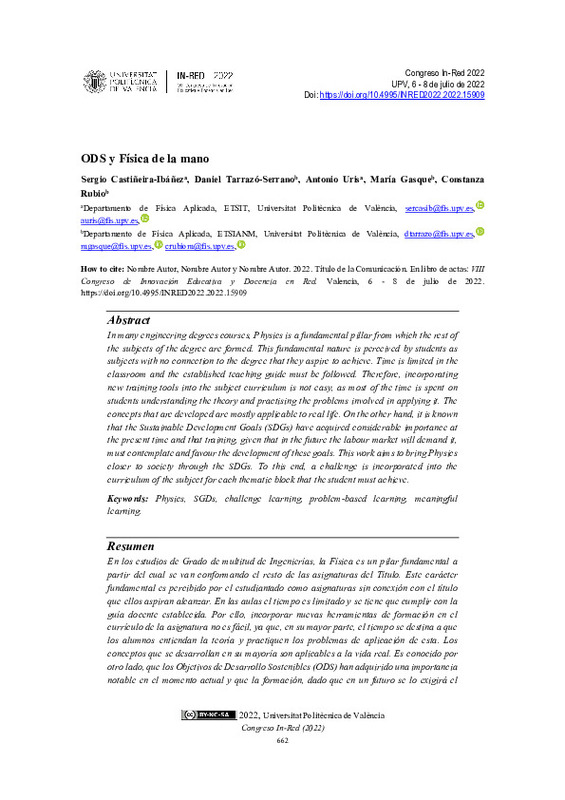JavaScript is disabled for your browser. Some features of this site may not work without it.
Buscar en RiuNet
Listar
Mi cuenta
Estadísticas
Ayuda RiuNet
Admin. UPV
ODS y Física de la mano
Mostrar el registro sencillo del ítem
Ficheros en el ítem
| dc.contributor.author | Castiñeira Ibáñez, Sergio
|
es_ES |
| dc.contributor.author | Tarrazó Serrano, Daniel
|
es_ES |
| dc.contributor.author | Uris Martínez, Antonio
|
es_ES |
| dc.contributor.author | Gasque Albalate, Maria Concepcion
|
es_ES |
| dc.contributor.author | Rubio Michavila, Constanza
|
es_ES |
| dc.date.accessioned | 2022-12-15T11:21:22Z | |
| dc.date.available | 2022-12-15T11:21:22Z | |
| dc.date.issued | 2022-10-28 | |
| dc.identifier.isbn | 9788413960173 | |
| dc.identifier.uri | http://hdl.handle.net/10251/190727 | |
| dc.description.abstract | [EN] In many engineering degrees courses, Physics is a fundamental pillar from which the rest of the subjects of the degree are formed. This fundamental nature is perceived by students as subjects with no connection to the degree that they aspire to achieve. Moreover, the students' level of education is very heterogeneous, especially in the firsts courses which makes it difficult to connect the subject with the world in which we live and encourages a lack of interest in them. On the other hand, time is limited in the classroom and the established teaching guide must be followed. Therefore, incorporating new training tools into the subject curriculum is not easy, as most of the time is spent on students understanding the theory and practising the problems involved in applying it. Often, the lack of practice in other subjects delays the achievement of these objectives. The concepts that are developed are mostly applicable to real life. On the other hand, it is known that the Sustainable Development Goals (SDGs) have acquired considerable importance at the present time and that training, given that in the future the labour market will demand it, must contemplate and favour the development of these goals. This work aims to bring Physics closer to society through the SDGs. To this end, a challenge is incorporated into the curriculum of the subject for each thematic block that the student must achieve. | es_ES |
| dc.description.abstract | [ES] En los estudios de Grado de multitud de Ingenierías, la Física es un pilar fundamental a partir del cual se van conformando el resto de las asignaturas del Título. Este carácter fundamental es percibido por el estudiantado como asignaturas sin conexión con el título que ellos aspiran alcanzar. En las aulas el tiempo es limitado y se tiene que cumplir con la guía docente establecida. Por ello, incorporar nuevas herramientas de formación en el currículo de la asignatura no es fácil, ya que, en su mayor parte, el tiempo se destina a que los alumnos entiendan la teoría y practiquen los problemas de aplicación de esta. Los conceptos que se desarrollan en su mayoría son aplicables a la vida real. Es conocido por otro lado, que los Objetivos de Desarrollo Sostenibles (ODS) han adquirido una importancia notable en el momento actual y que la formación, dado que en un futuro se lo exigirá el mercado laboral, debe contemplar y favorecer el desarrollo de estos. Este trabajo pretende acercar la Física a la sociedad a través de los ODS. Para ello se incorporan al currículo de la asignatura un reto, por cada bloque temático, que el alumno tiene que conseguir. | es_ES |
| dc.format.extent | 12 | es_ES |
| dc.language | Español | es_ES |
| dc.publisher | Editorial Universitat Politècnica de València | es_ES |
| dc.relation.ispartof | In-Red 2022 - VIII Congreso Nacional de Innovación Educativa y Docencia en Red | |
| dc.rights | Reconocimiento - No comercial - Compartir igual (by-nc-sa) | es_ES |
| dc.subject | Physics | es_ES |
| dc.subject | SGDs | es_ES |
| dc.subject | Challenge learning | es_ES |
| dc.subject | Problem-based learning | es_ES |
| dc.subject | Meaningful learning | es_ES |
| dc.subject | Física | es_ES |
| dc.subject | ODS | es_ES |
| dc.subject | Aprendizaje por retos | es_ES |
| dc.subject | Aprendizaje basado en problemas | es_ES |
| dc.subject | Aprendizaje significativo | es_ES |
| dc.title | ODS y Física de la mano | es_ES |
| dc.type | Capítulo de libro | es_ES |
| dc.type | Comunicación en congreso | es_ES |
| dc.identifier.doi | 10.4995/INRED2022.2022.15909 | |
| dc.rights.accessRights | Abierto | es_ES |
| dc.contributor.affiliation | Universitat Politècnica de València. Departamento de Física Aplicada - Departament de Física Aplicada | es_ES |
| dc.contributor.affiliation | Universitat Politècnica de València. Escuela Técnica Superior de Ingenieros de Telecomunicación - Escola Tècnica Superior d'Enginyers de Telecomunicació | es_ES |
| dc.contributor.affiliation | Universitat Politècnica de València. Escuela Técnica Superior de Ingenieros Industriales - Escola Tècnica Superior d'Enginyers Industrials | es_ES |
| dc.contributor.affiliation | Universitat Politècnica de València. Centro de Tecnologías Físicas: Acústica, Materiales y Astrofísica - Centre de Tecnologies Físiques: Acústica, Materials i Astrofísica | es_ES |
| dc.contributor.affiliation | Universitat Politècnica de València. Escuela Técnica Superior de Ingeniería Agronómica y del Medio Natural - Escola Tècnica Superior d'Enginyeria Agronòmica i del Medi Natural | es_ES |
| dc.description.bibliographicCitation | Castiñeira Ibáñez, S.; Tarrazó Serrano, D.; Uris Martínez, A.; Gasque Albalate, MC.; Rubio Michavila, C. (2022). ODS y Física de la mano. En In-Red 2022 - VIII Congreso Nacional de Innovación Educativa y Docencia en Red. Editorial Universitat Politècnica de València. 662-673. https://doi.org/10.4995/INRED2022.2022.15909 | es_ES |
| dc.description.accrualMethod | OCS | es_ES |
| dc.relation.conferencename | IN-RED 2022: VIII Congreso de Innovación Educativa y Docencia en Red | es_ES |
| dc.relation.conferencedate | Julio 06-08, 2022 | es_ES |
| dc.relation.conferenceplace | Valencia, España | es_ES |
| dc.relation.publisherversion | http://ocs.editorial.upv.es/index.php/INRED/InRed2022/paper/view/15909 | es_ES |
| dc.description.upvformatpinicio | 662 | es_ES |
| dc.description.upvformatpfin | 673 | es_ES |
| dc.type.version | info:eu-repo/semantics/publishedVersion | es_ES |
| dc.relation.pasarela | OCS\15909 | es_ES |








